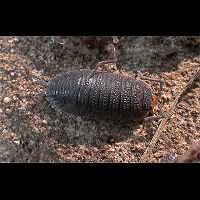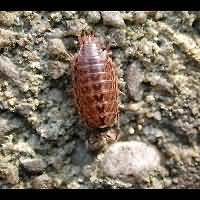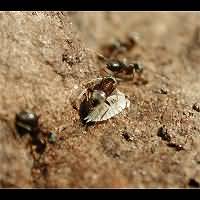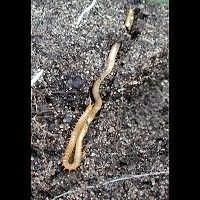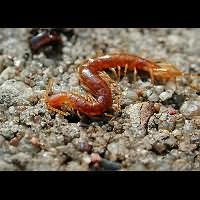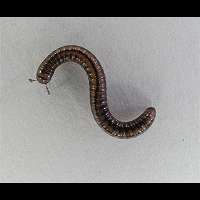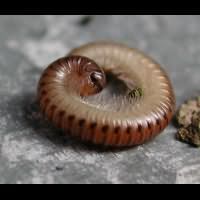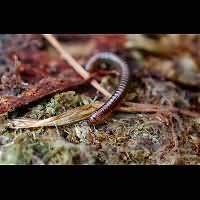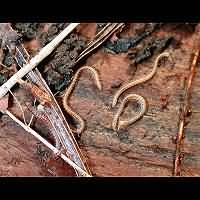[All pictures of garden wildlife on this page are thumbnails. Click on any thumbnail for a large format to be displayed.]
![]()
Centipedes, Millipedes and Woodlice (Myriapods and Isopods)
The 'little crawlers' centipedes, millipedes and woodlice are all arthropods. Centipedes and millipedes both are similarly shaped and their striking feature is a large number of legs. However, centipedes and millipedes are not closely related. There are significant differences between both groups. Centipedes are closely related to insects. The young of both centipedes and millipedes are called nymphs.Woodlice are not related to centipedes and millipedes at all. Actually they are crustaceans and thus related to crabs, shrimps and lobsters. They represent the only crustaceans living on land during their whole lifecycle. Woodlice breath through lungs on their hind legs These lungs must always be kept moist, otherwise they don't work. Woodlice is therefor always found in wet habitat. Long hot summers may kill many of them. Woodlice make up an uniform group of small animals. The smallest is around 0.5 centimeters, the biggest species dies not exceed 2 centimeters. The best places to look for woodlice are damp old cellars, or under rocks and logs. It is common to find several species together. Very few woodlice live in water. All woodlice hardly ever feed on living plants. Along with earth worms and millipedes, woodlice are important natural recyclers of waste organic material. Given the right living conditions a woodlouse may live up to two years.
Centipedes have one pair of legs on each segment of their body. They can grind and all are carnivores. They are capable of injecting a poison into their prey to paralyze it. The bite of the largest species is dangerous even for humans. It is not lethal except for people with a specific allergy. The biggest centipedes live in South America and may grow to a length of some 30 centimeters. They even eat birds and mice. Some of these big species can be well kept in a terrarium where they may reach the age of ten years. In Western Europe we usually see two types of centipedes: short and long species. Short ones, usually brown in colour are fast runners. The longer species are usually yellow and live under the ground. These move about much more slowly. Both types are often found by overturning stones, rocks and logs.
Millipedes have numeous legs but - contrary to what the name suggests - there is not one single species reaching a thousand legs. Some species count as many as 130 pairs of legs, which means they have 260 legs. If you have that many legs, you better be careful not to trip over them. That is why millipedes walk relatively slowly. The true reason why they are so slow is that the two pairs of legs do not move simultanously. Millipedes do not have any poison. They don't need it, for all eat plants, decaying plants or even dead animals. Some species produce a badly smelling substance just like the Stink Bugs do. This is millipedes' defence weapon. You can sucessfully keep millipedes in a terrarium. The biggest species may be 20 centimeters long and live up to nearly ten years.
Common Shiny Woodlouse (Oniscus asellus)
The Common Shiny Woodlouse is a very common species, often seen together with the Common Rough Woodlouse. More...
The Common Shiny Woodlouse is a very common species, often seen together with the Common Rough Woodlouse. More...
Common Rough Woodlouse (Porcellio scaber)
The Common Rough Woodlouse usually is a very grey species. More...
The Common Rough Woodlouse usually is a very grey species. More...
Common Striped Woodlouse (Philoscia muscorum)
The Common Striped Woodlouse usually is rather colourful species. More...
The Common Striped Woodlouse usually is rather colourful species. More...
Ant Woodlouse (Platyarthrus hoffmannseggi)
The Ant Woodlouse lives in ant's nests exclusively. More...
The Ant Woodlouse lives in ant's nests exclusively. More...
Ground Lover Centipede (Haplophilus subterraneus)
One of the tallest centipedes in Western Europe: the Ground Lover Centipede. More...
One of the tallest centipedes in Western Europe: the Ground Lover Centipede. More...
Brachyiulus pusillus
Brachyiulus pusillus is fond of climbing therefore it can often be spotted up in the trees, on walls and fences. More...
Brachyiulus pusillus is fond of climbing therefore it can often be spotted up in the trees, on walls and fences. More...
Blunt-tailed Snake Millipede (Cylindroiulus punctatus)
The Blunt-tailed Snake Millipede has some 100 legs, yet it moves about slowly. More...
The Blunt-tailed Snake Millipede has some 100 legs, yet it moves about slowly. More...
Julus scandinavius
In the genus Julus there are some four species in Britain. They are hard to tell apart, but this is most likely Julus scandinavius. More...
In the genus Julus there are some four species in Britain. They are hard to tell apart, but this is most likely Julus scandinavius. More...
Spotted Snake Millipede (Blaniulus guttulatus)
The Red-spotted Milliped is quite a beautiful animal. More...
The Red-spotted Milliped is quite a beautiful animal. More...
Proteroiulus fuscus
Proteroiulus fuscus is very similar to Spotted Snake Milliped (Blaniulus guttulatus). More...
Proteroiulus fuscus is very similar to Spotted Snake Milliped (Blaniulus guttulatus). More...
Flat-backed Millipede (Polydesmus angustus)
Proteroiulus fuscus is a very common species in gardens. The white one in the photo has just moulted. More...
Proteroiulus fuscus is a very common species in gardens. The white one in the photo has just moulted. More...

© Copyright 1998-2024 gardensafari.net (Hania Berdys)

 English / engels
English / engels  Dutch / nederlands
Dutch / nederlands
